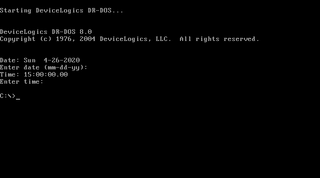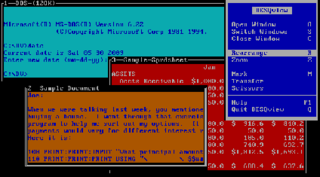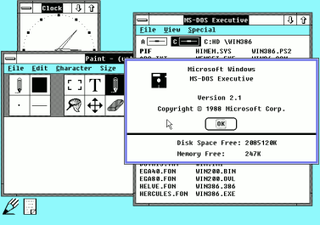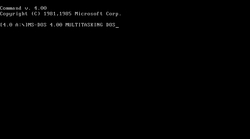
The Intel 80286 is a 16-bit microprocessor that was introduced on February 1, 1982. It was the first 8086-based CPU with separate, non-multiplexed address and data buses and also the first with memory management and wide protection abilities. The 80286 used approximately 134,000 transistors in its original nMOS (HMOS) incarnation and, just like the contemporary 80186, it could correctly execute most software written for the earlier Intel 8086 and 8088 processors.

In computer data storage, drive letter assignment is the process of assigning alphabetical identifiers to volumes. Unlike the concept of UNIX mount points, where volumes are named and located arbitrarily in a single hierarchical namespace, drive letter assignment allows multiple highest-level namespaces. Drive letter assignment is thus a process of using letters to name the roots of the "forest" representing the file system; each volume holds an independent "tree".

DR-DOS is a disk operating system for IBM PC compatibles. Upon its introduction in 1988, it was the first DOS that attempted to be compatible with IBM PC DOS and MS-DOS.

Xenix is a discontinued version of the Unix operating system for various microcomputer platforms, licensed by Microsoft from AT&T Corporation in the late 1970s. The Santa Cruz Operation (SCO) later acquired exclusive rights to the software, and eventually replaced it with SCO UNIX.

Digital Research, Inc. was a privately held American software company created by Gary Kildall to market and develop his CP/M operating system and related 8-bit, 16-bit and 32-bit systems like MP/M, Concurrent DOS, FlexOS, Multiuser DOS, DOS Plus, DR DOS and GEM. It was the first large software company in the microcomputer world. Digital Research was originally based in Pacific Grove, California, later in Monterey, California.

DESQview (DV) is a text mode multitasking operating environment developed by Quarterdeck Office Systems which enjoyed modest popularity in the late 1980s and early 1990s. Running on top of DOS, it allows users to run multiple programs concurrently in multiple windows.
In computing, the DOS Protected Mode Interface (DPMI) is a specification introduced in 1989 which allows a DOS program to run in protected mode, giving access to many features of the new PC processors of the time not available in real mode. It was initially developed by Microsoft for Windows 3.0, although Microsoft later turned control of the specification over to an industry committee with open membership. Almost all modern DOS extenders are based on DPMI and allow DOS programs to address all memory available in the PC and to run in protected mode.

TopView is the first object-oriented, multitasking, and windowing, personal computer operating environment for PC DOS developed by IBM, announced in August 1984 and shipped in March 1985. TopView provided a text-mode operating environment that allowed users to run more than one application at the same time on a PC. IBM demonstrated an early version of the product to key customers before making it generally available, around the time they shipped their new PC AT computer.
Virtual DOS machines (VDM) refer to a technology that allows running 16-bit/32-bit DOS and 16-bit Windows programs when there is already another operating system running and controlling the hardware.

Multiuser DOS is a real-time multi-user multi-tasking operating system for IBM PC-compatible microcomputers.
FlexOS is a discontinued modular real-time multiuser multitasking operating system (RTOS) designed for computer-integrated manufacturing, laboratory, retail and financial markets. Developed by Digital Research's Flexible Automation Business Unit in Monterey, California, in 1985, the system was considered to become a successor of Digital Research's earlier Concurrent DOS, but with a new, modular, and considerably different system architecture and portability across several processor families. Still named Concurrent DOS 68K and Concurrent DOS 286, it was renamed into FlexOS on 1 October 1986 to better differentiate the target audiences. FlexOS was licensed by several OEMs who selected it as the basis for their own operating systems like 4680 OS, 4690 OS, S5-DOS/MT and others. Unrelated to FlexOS, the original Concurrent DOS system architecture found a continuation in successors like Concurrent DOS XM and Concurrent DOS 386 as well.
This article presents a timeline of events in the history of 16-bit x86 DOS-family disk operating systems from 1980 to present. Non-x86 operating systems named "DOS" are not part of the scope of this timeline.

Windows 2.1 is a major release of Microsoft Windows. It was released to manufacturing on May 27, 1988, as a successor to Windows 2.0.

MS-DOS is an operating system for x86-based personal computers mostly developed by Microsoft. Collectively, MS-DOS, its rebranding as IBM PC DOS, and a few operating systems attempting to be compatible with MS-DOS, are sometimes referred to as "DOS". MS-DOS was the main operating system for IBM PC compatibles during the 1980s, from which point it was gradually superseded by operating systems offering a graphical user interface (GUI), in various generations of the graphical Microsoft Windows operating system.

DOS is a family of disk-based operating systems for IBM PC compatible computers. The DOS family primarily consists of IBM PC DOS and a rebranded version, Microsoft's MS-DOS, both of which were introduced in 1981. Later compatible systems from other manufacturers include DR-DOS (1988), ROM-DOS (1989), PTS-DOS (1993), and FreeDOS (1998). MS-DOS dominated the IBM PC compatible market between 1981 and 1995.
The ICL DRS was a range of departmental computers from International Computers Limited (ICL). Standing originally for Distributed Resource System, the full name was later dropped in favour of the abbreviation.
VM/386 is a multitasking Multi-user environment or 'control program' that took early advantage of the capabilities of Intel's 386 processor. By utilizing Virtual 8086 mode, users were able to run their existing text-based and graphical DOS software in safely separate environments. The system offered a high degree of control, with the ability to set memory limits, CPU usage and scheduling parameters, device assignments, and interrupt priorities through a virtual machine manager menu. Unique CONFIG.SYS and AUTOEXEC.BAT files could be configured for each application, and even different DOS versions. In 1991 the vendor announced intentions to support DPMI 1.0 in VM/386.
DOS 286 or DOS/286 may refer to:











